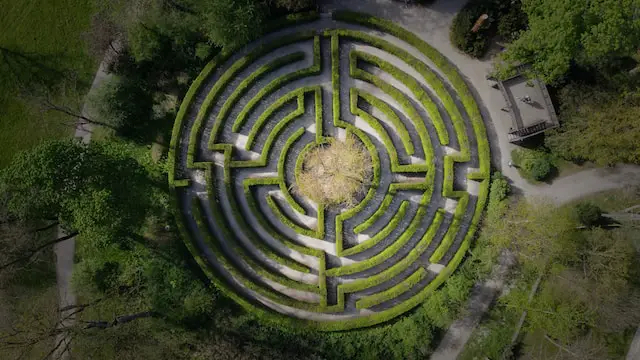Mazes are much more complicated than labyrinths and require problem solving to get from one point to another. Labyrinths, on the other hand, involve only one path with no dead ends or wrong turns that you can take.
What is a labyrinth?
(Photo by Ben Mathis Seibel on Unsplash )

A labyrinth is a complex and intricate maze-like structure that features a single, unbroken path that winds and twists its way through the design. Unlike a maze, which is designed to be confusing and challenging to navigate, a labyrinth has a single, clear path that leads to its center and then back out again.
Labyrinths have been used for thousands of years in various cultures and traditions as spiritual and symbolic tools for meditation, prayer, and contemplation. Walking a labyrinth is often seen as a metaphor for life’s journey, with its twists and turns, and can be used as a form of mindfulness practice.
What is a Maze?
(Photo by Mitchell Luo on Unsplash )

A maze is a complex and confusing network of passages or paths that are designed to be challenging to navigate. Unlike a labyrinth, which has a single, clear path, a maze has multiple paths that may lead to dead ends, loops, or other paths. The goal of a maze is to navigate through it to reach a specific endpoint or goal.
Mazes are often used as a form of entertainment or challenge, such as in puzzles or games. They can also be used as a form of exercise, as navigating through a maze can require physical exertion and coordination. Mazes have a long history and have been found in various cultures and time periods, from ancient Greece to modern-day amusement parks.
The difference between labyrinth and maze
The main difference between a labyrinth and a maze is in their design and purpose. While both are intricate structures that involve navigating through a complex network of paths, there are some key distinctions:
Design: A labyrinth has a single, unbroken path that winds its way through the design and leads to the center, while a maze has multiple paths, dead ends, and loops that can be confusing to navigate.
Purpose: Labyrinths are often used for meditation, contemplation, or spiritual purposes, while mazes are usually designed for entertainment or challenge.
Difficulty: Labyrinths are usually relatively easy to navigate, as there is only one path to follow, while mazes can be more challenging and require problem-solving skills to find the correct path.
Shape: Labyrinths are often circular or spiral in shape, while mazes can have a variety of shapes and designs.
Labyrinths are designed to promote relaxation and inner reflection, while mazes are designed to provide a fun and challenging experience.
The history of labyrinths and mazes
Labyrinths have been found in many different cultures, all over the world. They have been used for religious, spiritual, and ceremonial purposes. Mazes, on the other hand, have mostly been used for entertainment and puzzle-solving.
The first known labyrinth was built by the Minoans, on the island of Crete, around 4000 BCE. This labyrinth was designed to be an elaborate burial complex for a powerful king or queen. It was a large and complicated structure, with many twists and turns. The most famous labyrinth from this time period is the one featured in the Greek myth of Theseus and the Minotaur.
Labyrinths continued to be popular in various cultures throughout history. In medieval Europe, they were often used as symbols of power and prestige. Many churches and cathedrals were built with labyrinths incorporated into their design. In Native American cultures, labyrinths were sometimes used in healing rituals.
Mazes first became popular in England during the 17th century. They were often created as garden features, to add interest and intrigue to a space. Maze designs became increasingly complex over time, as people tried to outdo each other with ever-more convoluted paths.
Today, both labyrinths and mazes can be found all over the world. They continue to be popular as places of contemplation and reflection, as well as challenges for those who enjoy solving puzzles.
How to build a maze
Mazes can be constructed from a variety of materials, including hedges, brick walls, or even corn stalks. The most important factor in building a successful maze is to create a design that will challenge and confuse those who attempt to navigate it.
There are a few key things to keep in mind when designing your maze:
- Dead ends should be plentiful. This will make it more difficult for people to find their way out and add to the overall confusion of the maze.
- The path should twist and turn as much as possible. This will make it more difficult for people to see where they are going and increase the chances of them getting lost.
- There should be multiple entrances and exits. This will allow people to enter and exit the maze at different points, making it more challenging to find their way out.
- It is helpful to use landmarks or other objects to help people orient themselves within the maze. This can be anything from statues or sculptures to large rocks or trees.
- If possible, incorporate tunnels or bridges into your design. These features add an extra level of difficulty for people trying to navigate the maze.
Can you escape a labyrinth?
Yes, you can escape a labyrinth. A labyrinth is a space with a complex series of paths, the goal of which is to reach the center. There is only one path in and out of the labyrinth, so it is possible to find your way out if you keep moving in the same direction. A maze, on the other hand, has multiple paths and dead ends, making it much more difficult to find your way out.
What are some famous labyrinths?
There are many famous labyrinths around the world, both historical and modern. Here are a few examples:
- The Labyrinth of Knossos: Located on the island of Crete in Greece, this ancient labyrinth is said to have been built by the legendary craftsman Daedalus for King Minos. According to myth, it was home to the Minotaur, a creature with the head of a bull and the body of a man.
- Chartres Cathedral Labyrinth: This famous medieval labyrinth is located in the nave of Chartres Cathedral in France. It dates back to the early 13th century and is made of limestone. It is a popular site for pilgrimage and spiritual contemplation.
- Hampton Court Maze: Located in the gardens of Hampton Court Palace in England, this maze was commissioned by King William III in the late 17th century. It is still open to the public today and is a popular tourist attraction.
- La Jolla Cove Labyrinth: This modern labyrinth is located on the beach in La Jolla, California. It was created by artist Eduardo Aguilera in 2007 and is made of stones. It has become a popular spot for meditation and reflection.
- Villa Pisani Labyrinth: Located in Stra, Italy, this elaborate maze was commissioned by Alvise Pisani in the late 1700s. It features many dead ends and false paths and was designed to challenge visitors.
Featured Image By – Parrish Freeman on Unsplash








